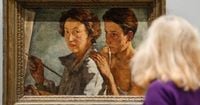In the heart of Düsseldorf, a bold new exhibition is rewriting the script on modern art history. Titled "Queer Modernism. 1900 to 1950," this expansive show opens its doors to the public on Friday, September 26, 2025, at the Kunstsammlung Nordrhein-Westfalen, promising to shine a long-overdue spotlight on the vibrant, complex, and often marginalized contributions of queer artists to the modernist movement. With more than 130 works by 34 artists, the exhibition is being hailed as a landmark moment for art lovers and historians alike, aiming to challenge old prejudices and broaden the narrative of who shaped modernism.
"This is the first major exhibition on this topic in Europe, if not worldwide," Susanne Gaensheimer, director of the Kunstsammlung Nordrhein-Westfalen, told The Associated Press. Her words reflect the sense of occasion that surrounds the show, which brings together paintings, drawings, photographs, sculptures, and films from across Europe and the United States. The exhibition is not just about art—it’s about reclaiming stories, identities, and a place in the canon for those who have too often been left on the margins.
The period covered by the exhibition—1900 to 1950—was marked by dramatic shifts in both society and art. In cosmopolitan centers like Paris and Berlin, greater sexual freedom flourished, drawing queer artists from around the world seeking a more open environment. Yet, these decades also witnessed the rise of fascism, the criminalization of homosexuality, and brutal waves of persecution, especially after 1933 when the Nazis seized power in Germany. As Gaensheimer put it, "The queer artists you see in this exhibition were part of a very lively network in their day. Many of them were successful in their day, sold works, and were part of a very intense movement and also part of the avant-garde."
The exhibition’s scope is impressive, not only in the number of works but also in the diversity of themes it tackles—desire, gender, sexuality, discrimination, and oppression. The artists represented hail from all over Europe and the United States, with many having moved to Europe in the early 20th century to enjoy a more liberal climate. Some artists used coded language and imagery to express their sexuality, while others were remarkably open, even defiant, in their work. The result is a collection that brims with variety, both in style and in the ways queerness is celebrated or shielded.
Among the standout pieces is the oil painting "I and My Model" (1929/30) by German-Swedish artist Lotte Laserstein. The painting shows Laserstein at work, palette and paintbrush in hand, with her lover and preferred model, Traute Rose, gazing tenderly over her shoulder. This intimate scene captures both the personal and professional partnership between the two women, offering a window into a world rarely depicted so openly at the time.
Another highlight is Ludwig von Hofmann’s "The Source" (1913), a luminous scene of three young, beautiful, naked men lingering around a spring, drinking and eyeing one another. This painting was purchased in 1914 by famed German author Thomas Mann, who, despite his marriage and family, is known for his homosexual desires—expressed both in his diaries and, with subtlety, in his fiction. According to The Associated Press, the painting accompanied Mann through his exiles in California and Switzerland, hanging in his study as a silent testament to the private worlds he inhabited.
The exhibition is divided into eight chapters, each exploring a different facet of queer modernism. One particularly powerful section is dedicated to queer resistance since 1933, charting the period when the Nazis began targeting homosexuals with persecution, deportation, and murder in concentration camps. Some artists responded with resistance or by emigrating; others, in a bid for survival, collaborated with fascist regimes. The show does not shy away from these complexities, instead offering a nuanced look at the choices queer artists faced during one of history’s darkest chapters.
But for all the hardship and danger, the exhibition is also a celebration—a sometimes hidden, sometimes exuberant affirmation of queer life and creativity. Take, for instance, "Bank Holiday Monday" by Gluck (born Hannah Gluckstein in London in 1895), which depicts a flamboyantly dressed, androgynous figure at a fairground, their extravagant yellow-red-blue scarf a splash of color and confidence. A second person stands just behind, and there’s an unmistakable sense of intimate tension between the two. As the Associated Press describes, both figures appear "at the same time affectionate and self-confident," embodying the resilience and joy that runs through much of the work on display.
The show’s curators have gone to great lengths to ensure that this is not a one-dimensional portrait of queer experience. The exhibition was curated in cooperation with a queer advisory board, and the museum will host a range of readings, tours, and workshops in the coming months, inviting visitors to engage more deeply with the themes on offer. This is not just about looking back—it’s about starting conversations that are still urgently relevant today.
One of the challenges the exhibition addresses is the historical marginalization of queer artists. Many of their works were scattered across the globe due to the upheavals of two world wars, and the fact that many artists had no descendants to preserve their legacies. As a result, their perspectives were often excluded from the traditional art-historical canon. Gaensheimer acknowledges this, noting, "We have been working very intensively for several years now to continually focus on new perspectives on modernism and to introduce artists who are not yet well known, or to present trends and styles that do not appear in the classic narrative of modernism." The goal, she says, is to "broaden the perspective on what modernism was and who contributed to it."
For visitors, the exhibition offers not just a feast for the eyes, but a chance to rethink what they know about art, identity, and resilience. It’s a reminder that queer artists were not just on the fringes—they were at the heart of modernism, shaping its evolution in ways that are only now being fully recognized. The show runs through February 15, 2026, giving art lovers and curious minds plenty of time to experience a story that’s as much about the present as it is about the past.
With "Queer Modernism. 1900 to 1950," Düsseldorf’s Kunstsammlung Nordrhein-Westfalen is making a powerful statement: the story of modern art is richer, more complex, and more inclusive than many have been led to believe. And for anyone eager to see history through a wider lens, this is an exhibition not to be missed.



